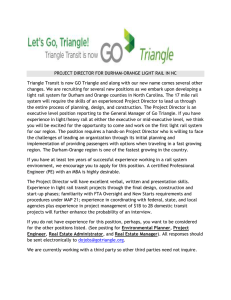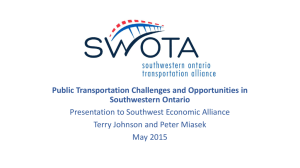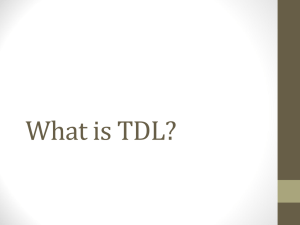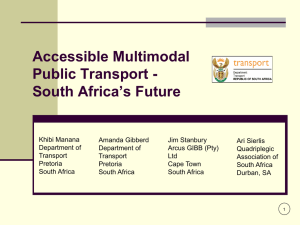Lecture 3
advertisement
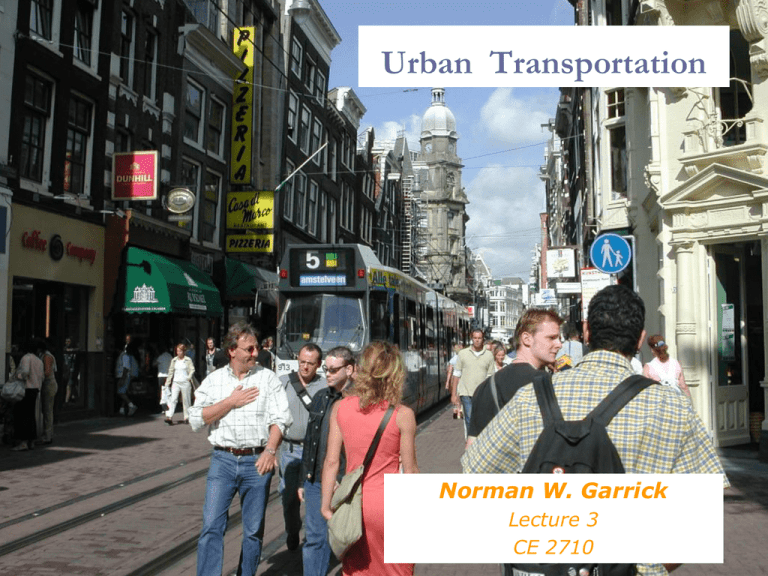
Urban Transportation Norman W. Garrick Lecture 3 CE 2710 Basics of Urban Transportation A. Transportation in the urban environment is complex and diverse, not only in terms of the modes of transportation that are used, but also in terms of the varied operations of these modes and the complex interaction between the various modes and the other aspects of the city. B. Transportation in the urban context works best when the various modes are linked together as a seamless whole that give people convenient choices for meeting various needs. A. A transportation system that is most effective should be fully integrated into the life of the city and should not disrupt the other important activities that are necessary for the functioning of a city. Travel Budget Some transportation historians have put forward the concept of the 30 minute time budget that most people are willing to allot for commuting to work in each direction. They claim that this time budget has remained constant over time (at least one researcher in Austria developed a model human energy expenditure which he purports to be the basis for this invariant time budget over the centuries). The practical consequence of this constant time budget is that cities have expanded in size as technology has evolved to allow people to commute further in 30 minutes. Transportation and the Evolution of Urban Form Until the mid to late 1880s almost all people commuted by walking, the result was that all cities were very compact and designed for walking. The coming of the electric rail in various forms changed the shape and the size of cities. American cities like Philadelphia, Boston, Chicago, and even Los Angeles, are examples of cities that were shaped by rail. New cities like Phoenix and Atlanta are much different in form since they were largely shaped by automobile travel, which allowed a much sparser pattern of development. Modes of Urban Travel Non-motorized Travel II. Motorized Roadway Modes III.Fixed Guideway Modes IV. Other I. Non-motorized Travel 1. 2. 3. Walk Bike Others Motorized Roadway Modes 1. 2. 3. 4. 5. 6. Private auto (individual and shared ownership) Vanpools On-demand services (para-transit) Taxis Jitney Bus (Mini-bus, Articulated Bus, Bus Rapid Transit) Fixed Guideway Modes 1. 2. 3. 4. Fixed Guideway Buses (Bus Rapid Transit) Light Rail (Streetcars, Trams, Cable Cars) Rail Rapid Transits (subway, elevated rail) Commuter Rail Curitiba, Brazil Norman W. Garrick Curitiba, Brazil Norman W. Garrick Los Angeles Bus Rapid Transit (BRT) This is Wikipedia’s very good definition of Bus Rapid Transit Bus rapid transit (BRT) is a broad term given to a variety of different transportation systems that, through infrastructural and scheduling improvements, attempt to use buses to provide a service that is a higher quality than an ordinary bus line. Each BRT system utilizes different improvements, although many improvements are shared by many BRT systems. The goal of such systems is to at least approach the service quality of rail transit while still enjoying the cost savings of bus Berlin, Germany Portland, OR Norman W. Garrick Amsterdam Amsterdam Other Modes 1. 2. Water Aerial Trams Portland, OR A (Very) Rough Guide to Urban Rail Services (ref: The Transit Metropolis by Robert Cervero) Streetcars Trams Rail Rapid Transit (Subways etc) Commuter Rail Right of Way On-street, mixed traffic Exclusive ROW Exclusive ROW Station Spacing (in City Center) Less than ¼ mile ½ Mile NA Cars/train 1-4 Up to 8 Up to 12 Capacity 125-500 800-1600 1000-2000 Average Speed 12-25 mph 20-25 mph 30-90 mph The Importance of Walking Walking is the most important mode of transportation in a city. Buses and rail cannot provide optimum benefit in a city which does not have a good walking environment. A good working environment refers not just to the provision of side walks, but also relates to land use issues (are there activities within convenient walking distance?) and the overall urban fabric (is it attractive? Does it feel safe?). Advantages of a Multimodal Transportation System Although walking is most important to the functioning of a city. Only the very smallest cities can get by with just walking. Balanced multimodal transportation is extremely important to the well being and sustainability of most cities. For example, a city with a multimodal system will require much less space devoted to parking. As we have discussed, a multimodal system is likely to be much more robust overall. Essential Characteristics of a Good Transportation System The characteristics that you should look for in judging a transportation system include the following: Support all societal goals (economic, quality of life) Reliable Cost efficient Provide choices Is redundant Serve a diverse population (young, old, impaired) Safe (low fatality) Seamless Environmental stewardship Planning for a Multimodal System In the urban environment, where space is a premium, developing a multimodal transportation system requires an emphasis on good planning and creative engineering solutions The results of different choices are often not fully realized for many years, so a long term perspective is required Planning and design is made more complicated because each decision must take into account not just the transportation system, but also how that system supports and interacts with all activities in the city - but especially the land use activities

